FIAT PUNTO 2014 Owner handbook (in English)
Manufacturer: FIAT, Model Year: 2014, Model line: PUNTO, Model: FIAT PUNTO 2014Pages: 219, PDF Size: 3.67 MB
Page 171 of 219
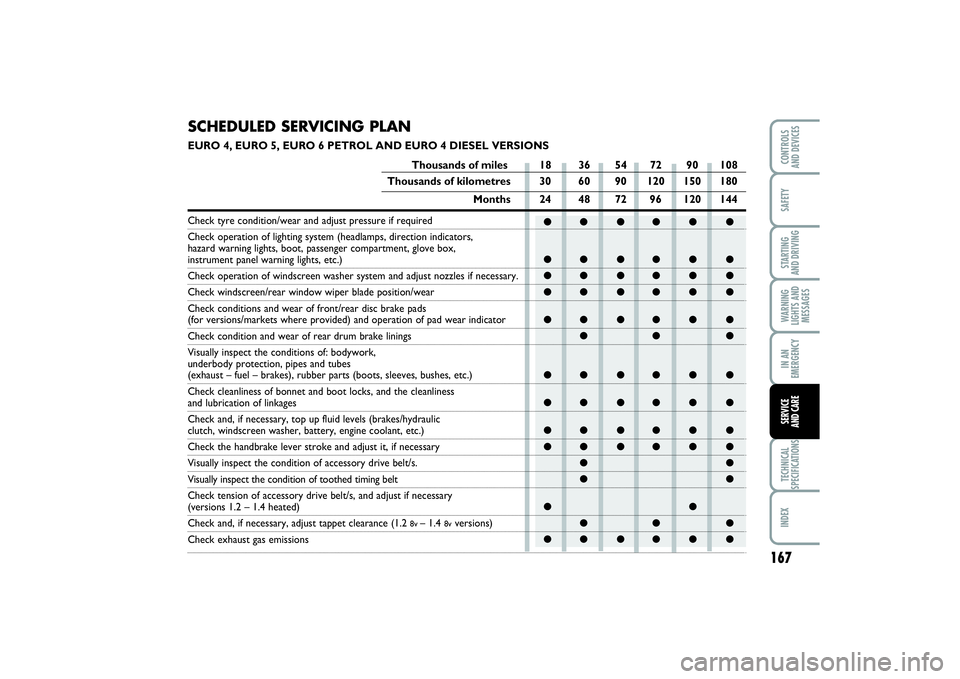
167
SAFETYSTARTING
AND DRIVINGWARNING
LIGHTS AND
MESSAGESIN AN
EMERGENCYTECHNICAL
SPECIFICATIONSINDEXCONTROLS
AND DEVICESSERVICE
AND CARE
‚óè‚óè ‚óè‚óè ‚óè ‚óè
‚óè‚óè ‚óè‚óè ‚óè ‚óè
‚óè‚óè ‚óè‚óè ‚óè ‚óè
‚óè‚óè ‚óè‚óè ‚óè ‚óè
‚óè‚óè ‚óè‚óè ‚óè ‚óè
‚óè‚óè ‚óè
‚óè‚óè ‚óè‚óè ‚óè ‚óè
‚óè‚óè ‚óè‚óè ‚óè ‚óè
‚óè‚óè ‚óè‚óè ‚óè ‚óè
‚óè‚óè ‚óè‚óè ‚óè ‚óè
‚óè‚óè
‚óè‚óè
‚óè‚óè
‚óè‚óè ‚óè
‚óè‚óè ‚óè‚óè ‚óè ‚óè
SCHEDULED SERVICING PLANEURO 4, EURO 5, EURO 6 PETROL AND EURO 4 DIESEL VERSIONS
Thousands of miles 18 36 54 72 90 108
Thousands of kilometres 30 60 90 120 150 180
Months 24 48 72 96 120 144
Check tyre condition/wear and adjust pressure if required
Check operation of lighting system (headlamps, direction indicators,
hazard warning lights, boot, passenger compartment, glove box, instrument panel warning lights, etc.)Check operation of windscreen washer system and adjust nozzles if necessary.Check windscreen/rear window wiper blade position/wear
Check conditions and wear of front/rear disc brake pads (for versions/markets where provided) and operation of pad wear indicatorCheck condition and wear of rear drum brake linings
Visually inspect the conditions of: bodywork,
underbody protection, pipes and tubes (exhaust – fuel – brakes), rubber parts (boots, sleeves, bushes, etc.)
Check cleanliness of bonnet and boot locks, and the cleanliness and lubrication of linkages
Check and, if necessary, top up fluid levels (brakes/hydraulic clutch, windscreen washer, battery, engine coolant, etc.) Check the handbrake lever stroke and adjust it, if necessaryVisually inspect the condition of accessory drive belt/s.Visually inspect the condition of toothed timing belt
Check tension of accessory drive belt/s, and adjust if necessary (versions 1.2 – 1.4 heated)Check and, if necessary, adjust tappet clearance (1.2
8v – 1.4
8vversions)
Check exhaust gas emissions
165-184 PUNTO POP 1ed EN 11/10/13 14.56 Pagina 167
Page 172 of 219
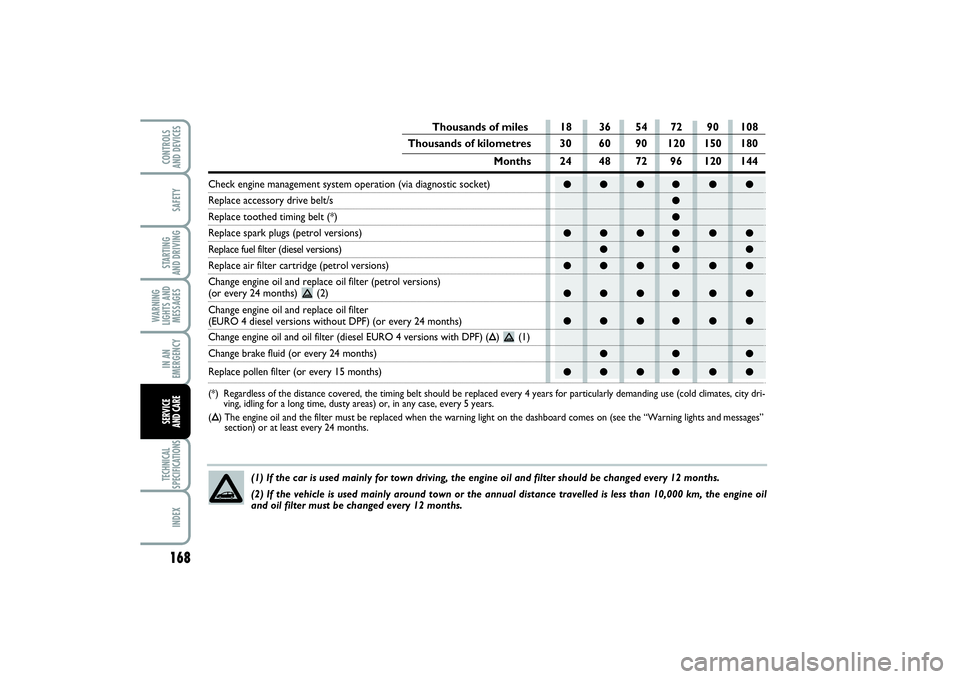
168SAFETYSTARTING
AND DRIVINGWARNING
LIGHTS AND
MESSAGESIN AN
EMERGENCYTECHNICAL
SPECIFICATIONSINDEXCONTROLS
AND DEVICESSERVICE
AND CARE
‚óè‚óè ‚óè‚óè ‚óè ‚óè
‚óè
‚óè
‚óè‚óè ‚óè‚óè ‚óè ‚óè
‚óè‚óè ‚óè
‚óè‚óè ‚óè‚óè ‚óè ‚óè
‚óè‚óè ‚óè‚óè ‚óè ‚óè
‚óè‚óè ‚óè‚óè ‚óè ‚óè
‚óè‚óè ‚óè
‚óè‚óè ‚óè‚óè ‚óè ‚óè
Thousands of miles 18 36 54 72 90 108
Thousands of kilometres 30 60 90 120 150 180
Months 24 48 72 96 120 144
Check engine management system operation (via diagnostic socket)Replace accessory drive belt/sReplace toothed timing belt (*)Replace spark plugs (petrol versions)Replace fuel filter (diesel versions)Replace air filter cartridge (petrol versions)
Change engine oil and replace oil filter (petrol versions) (or every 24 months) (2)
Change engine oil and replace oil filter (EURO 4 diesel versions without DPF) (or every 24 months)Change engine oil and oil filter (diesel EURO 4 versions with DPF) (
Õ) (1)
Change brake fluid (or every 24 months)Replace pollen filter (or every 15 months) (*) Regardless of the distance covered, the timing belt should be replaced every 4 years for particularly demanding use (cold climates, city dri-
ving, idling for a long time, dusty areas) or, in any case, every 5 years.
(Õ) The engine oil and the filter must be replaced when the warning light on the dashboard comes on (see the “Warning lights and messages”
section) or at least every 24 months.
(1) If the car is used mainly for town driving, the engine oil and filter should be changed every 12 months.
(2) If the vehicle is used mainly around town or the annual distance travelled is less than 10,000 km, the engine oil
and oil filter must be changed every 12 months.
165-184 PUNTO POP 1ed EN 11/10/13 14.56 Pagina 168
Page 173 of 219
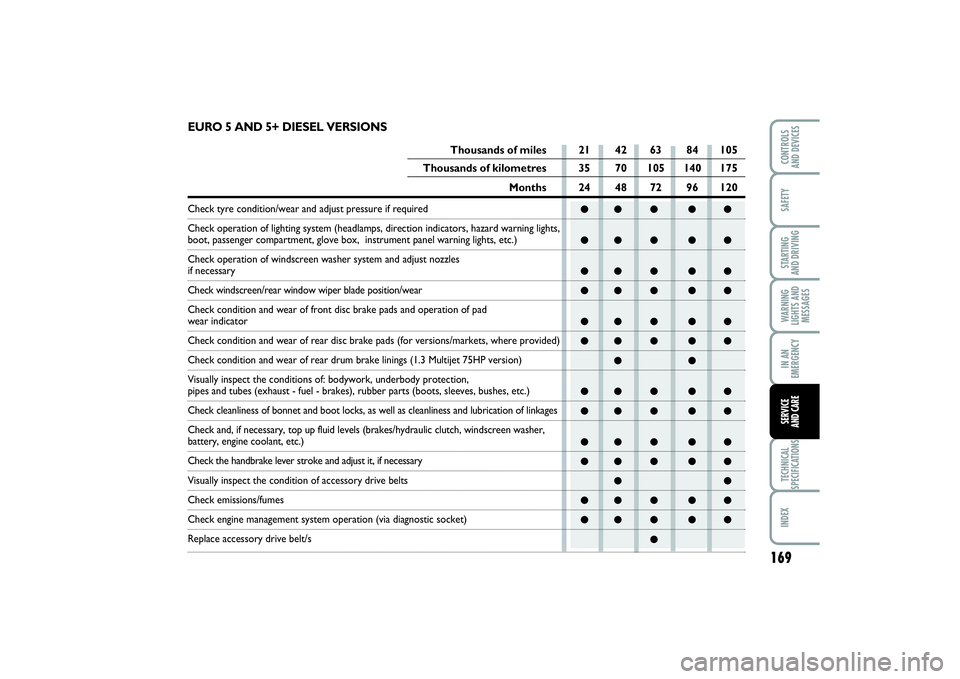
169
SAFETYSTARTING
AND DRIVINGWARNING
LIGHTS AND
MESSAGESIN AN
EMERGENCYTECHNICAL
SPECIFICATIONSINDEXCONTROLS
AND DEVICESSERVICE
AND CARE
‚óè‚óè ‚óè ‚óè ‚óè
‚óè‚óè ‚óè ‚óè ‚óè
‚óè‚óè ‚óè ‚óè ‚óè
‚óè‚óè ‚óè ‚óè ‚óè
‚óè‚óè ‚óè ‚óè ‚óè
‚óè‚óè ‚óè ‚óè ‚óè
‚óè‚óè
‚óè‚óè ‚óè ‚óè ‚óè
‚óè‚óè ‚óè ‚óè ‚óè
‚óè‚óè ‚óè ‚óè ‚óè
‚óè‚óè ‚óè ‚óè ‚óè
‚óè‚óè
‚óè‚óè ‚óè ‚óè ‚óè
‚óè‚óè ‚óè ‚óè ‚óè
‚óè
EURO 5 AND 5+ DIESEL VERSIONS
Thousands of miles 21 42 63 84 105
Thousands of kilometres 35 70 105 140 175
Months 24 48 72 96 120
Check tyre condition/wear and adjust pressure if required
Check operation of lighting system (headlamps, direction indicators, hazard warning lights, boot, passenger compartment, glove box, instrument panel warning lights, etc.)
Check operation of windscreen washer system and adjust nozzles if necessaryCheck windscreen/rear window wiper blade position/wear
Check condition and wear of front disc brake pads and operation of pad wear indicatorCheck condition and wear of rear disc brake pads (for versions/markets, where provided)Check condition and wear of rear drum brake linings (1.3 Multijet 75HP version)
Visually inspect the conditions of: bodywork, underbody protection, pipes and tubes (exhaust - fuel - brakes), rubber parts (boots, sleeves, bushes, etc.)Check cleanliness of bonnet and boot locks, as well as cleanliness and lubrication of linkages
Check and, if necessary, top up fluid levels (brakes/hydraulic clutch, windscreen washer, battery, engine coolant, etc.) Check the handbrake lever stroke and adjust it, if necessaryVisually inspect the condition of accessory drive beltsCheck emissions/fumesCheck engine management system operation (via diagnostic socket)Replace accessory drive belt/s
165-184 PUNTO POP 1ed EN 11/10/13 14.56 Pagina 169
Page 174 of 219
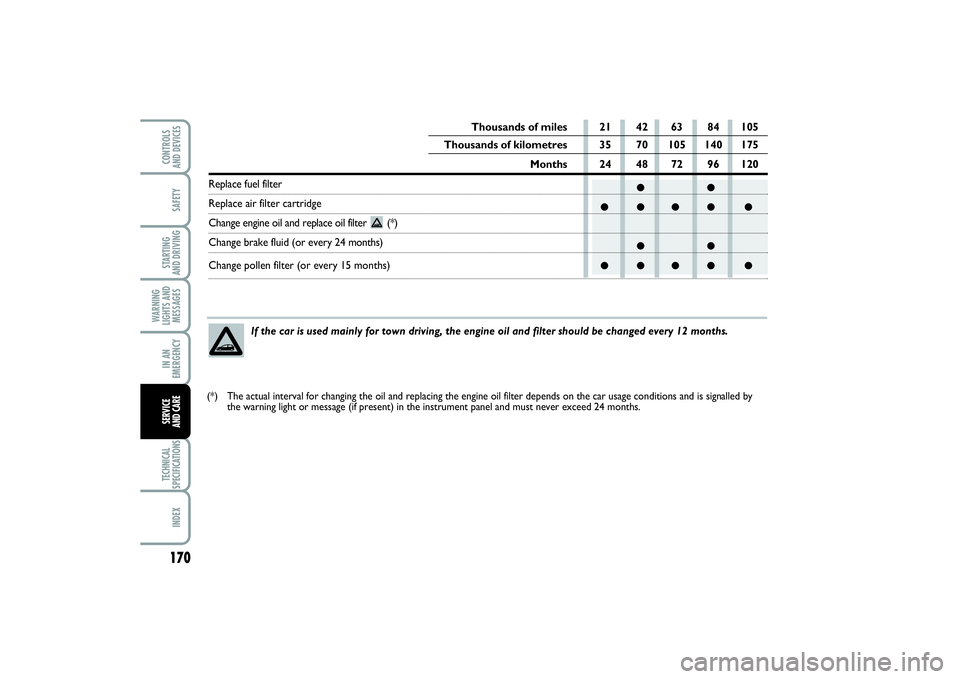
170SAFETYSTARTING
AND DRIVINGWARNING
LIGHTS AND
MESSAGESIN AN
EMERGENCYTECHNICAL
SPECIFICATIONSINDEXCONTROLS
AND DEVICESSERVICE
AND CARE
‚óè‚óè
‚óè‚óè‚óè‚óè ‚óè
‚óè‚óè
‚óè‚óè‚óè‚óè ‚óè
Thousands of miles 21 42 63 84 105
Thousands of kilometres 35 70 105 140 175
Months 24 48 72 96 120
Replace fuel filterReplace air filter cartridgeChange engine oil and replace oil filter (*)Change brake fluid (or every 24 months)
Change pollen filter (or every 15 months)
If the car is used mainly for town driving, the engine oil and filter should be changed every 12 months.
(*) The actual interval for changing the oil and replacing the engine oil filter depends on the car usage conditions and is signalled by
the warning light or message (if present) in the instrument panel and must never exceed 24 months.
165-184 PUNTO POP 1ed EN 11/10/13 14.56 Pagina 170
Page 175 of 219
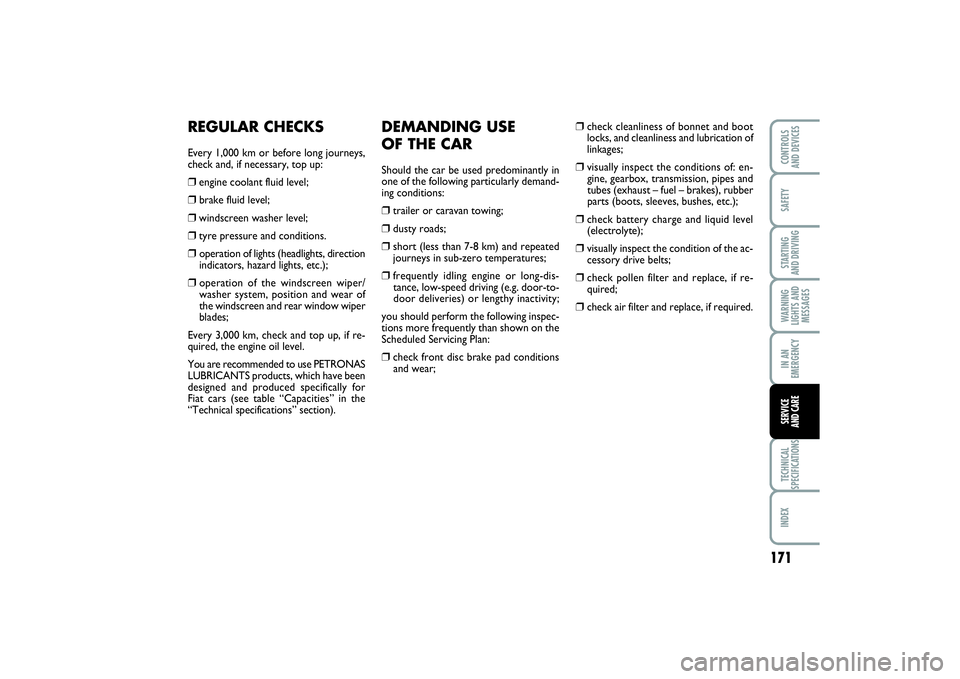
171
SAFETYSTARTING
AND DRIVINGWARNING
LIGHTS AND
MESSAGESIN AN
EMERGENCYTECHNICAL
SPECIFICATIONSINDEXCONTROLS
AND DEVICESSERVICE
AND CARE
DEMANDING USE
OF THE CARShould the car be used predominantly in
one of the following particularly demand-
ing conditions:‚ùí
trailer or caravan towing;
‚ùí
dusty roads;
‚ùí
short (less than 7-8 km) and repeated
journeys in sub-zero temperatures;
‚ùí
frequently idling engine or long-dis-
tance, low-speed driving (e.g. door-to-
door deliveries) or lengthy inactivity;
you should perform the following inspec-
tions more frequently than shown on the
Scheduled Servicing Plan:
‚ùí
check front disc brake pad conditions
and wear;
‚ùí
check cleanliness of bonnet and boot
locks, and cleanliness and lubrication of
linkages;
‚ùí
visually inspect the conditions of: en-
gine, gearbox, transmission, pipes and
tubes (exhaust – fuel – brakes), rubber
parts (boots, sleeves, bushes, etc.);
‚ùí
check battery charge and liquid level
(electrolyte);
‚ùí
visually inspect the condition of the ac-
cessory drive belts;
‚ùí
check pollen filter and replace, if re-
quired;
‚ùí
check air filter and replace, if required.
REGULAR CHECKSEvery 1,000 km or before long journeys,
check and, if necessary, top up:‚ùí
engine coolant fluid level;
‚ùí
brake fluid level;
‚ùí
windscreen washer level;
‚ùí
tyre pressure and conditions.
‚ùí
operation of lights (headlights, direction
indicators, hazard lights, etc.);
‚ùí
operation of the windscreen wiper/
washer system, position and wear of
the windscreen and rear window wiper
blades;
Every 3,000 km, check and top up, if re-
quired, the engine oil level.
You are recommended to use PETRONAS
LUBRICANTS products, which have been
designed and produced specifically for
Fiat cars (see table “Capacities” in the
“Technical specifications” section).
165-184 PUNTO POP 1ed EN 11/10/13 14.56 Pagina 171
Page 176 of 219
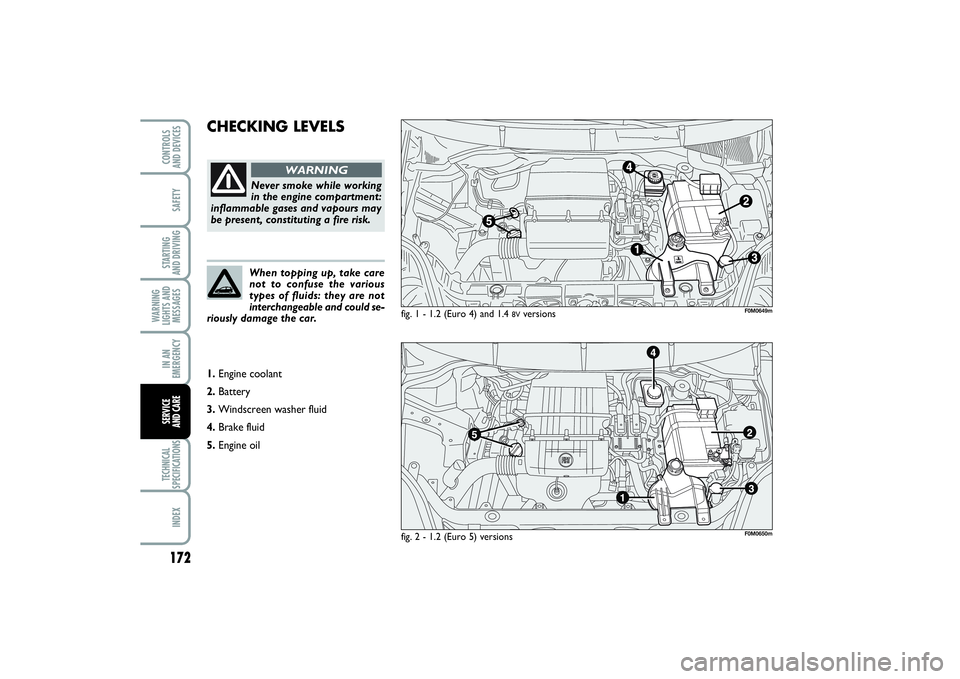
172SAFETYSTARTING
AND DRIVINGWARNING
LIGHTS AND
MESSAGESIN AN
EMERGENCYTECHNICAL
SPECIFICATIONSINDEXCONTROLS
AND DEVICESSERVICE
AND CARE
CHECKING LEVELS
fig. 1 - 1.2 (Euro 4) and 1.4
8Vversions
Never smoke while working
in the engine compartment:
inflammable gases and vapours may
be present, constituting a fire risk.
WARNING
When topping up, take care
not to confuse the various
types of fluids: they are not
interchangeable and could se-
riously damage the car.
1. Engine coolant
2. Battery
3. Windscreen washer fluid
4. Brake fluid
5. Engine oil
F0M0649m
fig. 2 - 1.2 (Euro 5) versions
F0M0650m
165-184 PUNTO POP 1ed EN 11/10/13 14.56 Pagina 172
Page 177 of 219
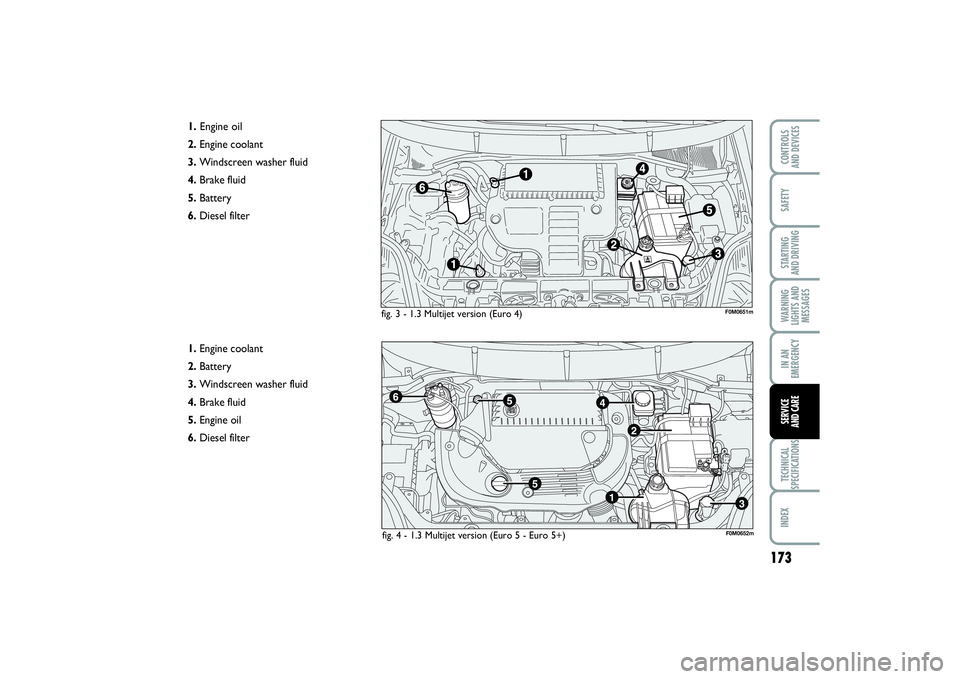
173
SAFETYSTARTING
AND DRIVINGWARNING
LIGHTS AND
MESSAGESIN AN
EMERGENCYTECHNICAL
SPECIFICATIONSINDEXCONTROLS
AND DEVICESSERVICE
AND CARE
fig. 3 - 1.3 Multijet version (Euro 4)
1.Engine oil
2. Engine coolant
3. Windscreen washer fluid
4. Brake fluid
5. Battery
6. Diesel filter1. Engine coolant
2. Battery
3. Windscreen washer fluid
4. Brake fluid
5. Engine oil
6. Diesel filter
F0M0651m
fig. 4 - 1.3 Multijet version (Euro 5 - Euro 5+)
F0M0652m
165-184 PUNTO POP 1ed EN 11/10/13 14.56 Pagina 173
Page 178 of 219
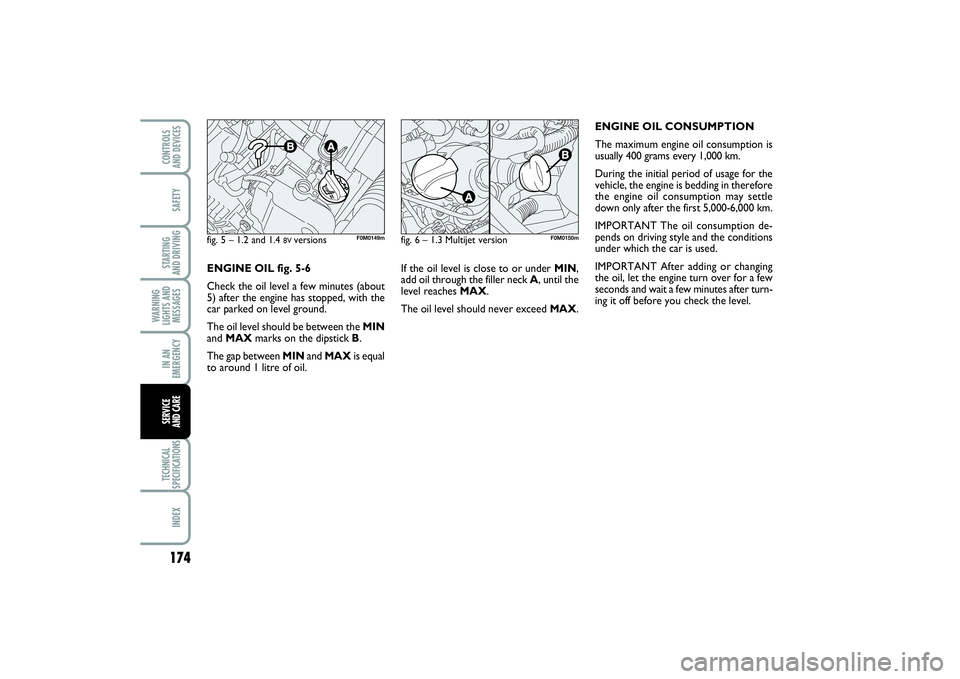
174SAFETYSTARTING
AND DRIVINGWARNING
LIGHTS AND
MESSAGESIN AN
EMERGENCYTECHNICAL
SPECIFICATIONSINDEXCONTROLS
AND DEVICESSERVICE
AND CARE
If the oil level is close to or under MIN,
add oil through the filler neck A, until the
level reaches MAX.
The oil level should never exceed MAX.ENGINE OIL CONSUMPTION
The maximum engine oil consumption is
usually 400 grams every 1,000 km.
During the initial period of usage for the
vehicle, the engine is bedding in therefore
the engine oil consumption may settle
down only after the first 5,000-6,000 km.
IMPORTANT The oil consumption de-
pends on driving style and the conditions
under which the car is used.
IMPORTANT After adding or changing
the oil, let the engine turn over for a few
seconds and wait a few minutes after turn-
ing it off before you check the level. ENGINE OIL fig. 5-6
Check the oil level a few minutes (about
5) after the engine has stopped, with the
car parked on level ground.
The oil level should be between the MIN
and MAXmarks on the dipstick B.
The gap between MINand MAXis equal
to around 1 litre of oil.
fig. 5 – 1.2 and 1.4
8V versions
F0M0149m
fig. 6 – 1.3 Multijet version
F0M0150m
165-184 PUNTO POP 1ed EN 11/10/13 14.56 Pagina 174
Page 179 of 219
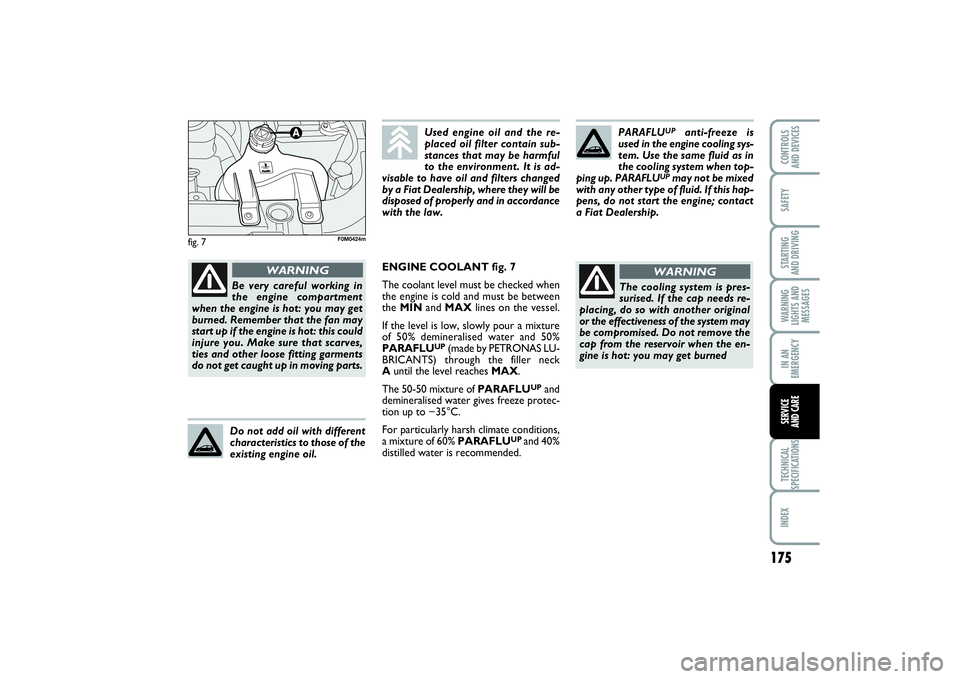
175
SAFETYSTARTING
AND DRIVINGWARNING
LIGHTS AND
MESSAGESIN AN
EMERGENCYTECHNICAL
SPECIFICATIONSINDEXCONTROLS
AND DEVICESSERVICE
AND CARE
fig. 7
PARAFLU
UP
anti-freeze is
used in the engine cooling sys-
tem. Use the same fluid as in
the cooling system when top-
ping up. PARAFLU
UP
may not be mixed
with any other type of fluid. If this hap-
pens, do not start the engine; contact
a Fiat Dealership.
The cooling system is pres-
surised. If the cap needs re-
placing, do so with another original
or the effectiveness of the system may
be compromised. Do not remove the
cap from the reservoir when the en-
gine is hot: you may get burned
WARNING
ENGINE COOLANT fig. 7
The coolant level must be checked when
the engine is cold and must be between
the MINand MAXlines on the vessel.
If the level is low, slowly pour a mixture
of 50% demineralised water and 50%
PARAFLU
UP
(made by PETRONAS LU-
BRICANTS) through the filler neck
Auntil the level reaches MAX.
The 50-50 mixture of PARAFLU
UP
and
demineralised water gives freeze protec-
tion up to −35°C.
For particularly harsh climate conditions,
a mixture of 60% PARAFLU
UP
and 40%
distilled water is recommended.
Used engine oil and the re-
placed oil filter contain sub-
stances that may be harmful
to the environment. It is ad-
visable to have oil and filters changed
by a Fiat Dealership, where they will be
disposed of properly and in accordance
with the law.
Do not add oil with different
characteristics to those of the
existing engine oil. Be very careful working in
the engine compartment
when the engine is hot: you may get
burned. Remember that the fan may
start up if the engine is hot: this could
injure you. Make sure that scarves,
ties and other loose fitting garments
do not get caught up in moving parts.
WARNING
F0M0424m
165-184 PUNTO POP 1ed EN 11/10/13 14.56 Pagina 175
Page 180 of 219
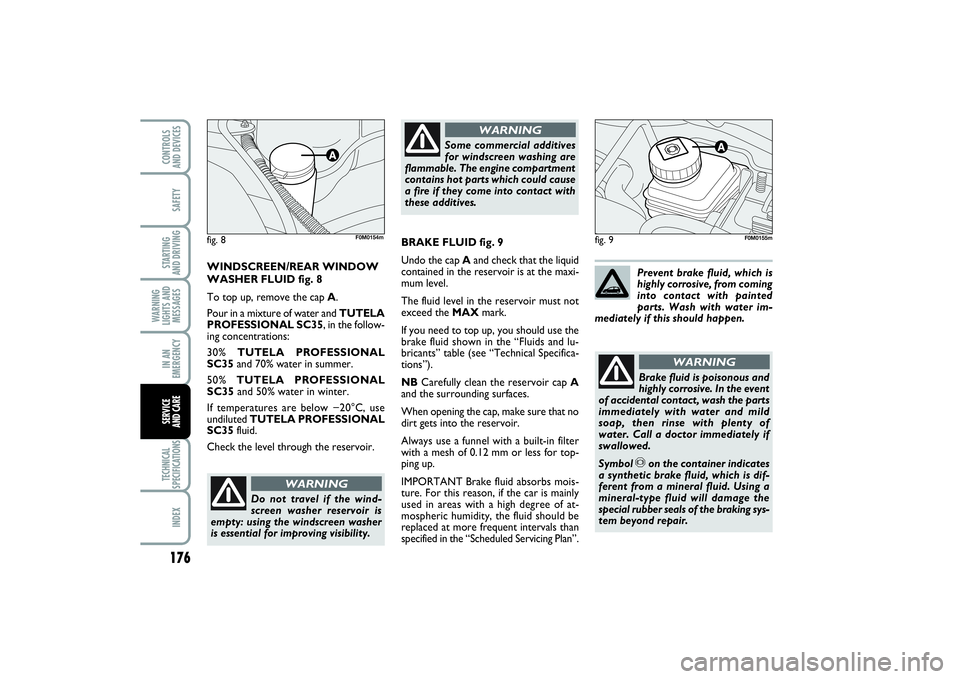
176SAFETYSTARTING
AND DRIVINGWARNING
LIGHTS AND
MESSAGESIN AN
EMERGENCYTECHNICAL
SPECIFICATIONSINDEXCONTROLS
AND DEVICESSERVICE
AND CARE
fig. 9
Do not travel if the wind-
screen washer reservoir is
empty: using the windscreen washer
is essential for improving visibility.
WARNING
Some commercial additives
for windscreen washing are
flammable. The engine compartment
contains hot parts which could cause
a fire if they come into contact with
these additives.
WARNING
Prevent brake fluid, which is
highly corrosive, from coming
into contact with painted
parts. Wash with water im-
mediately if this should happen.
WINDSCREEN/REAR WINDOW
WASHER FLUID fig. 8
To top up, remove the cap A.
Pour in a mixture of water and TUTELA
PROFESSIONAL SC35, in the follow-
ing concentrations:
30% TUTELA PROFESSIONAL
SC35and 70% water in summer.
50% TUTELA PROFESSIONAL
SC35and 50% water in winter.
If temperatures are below −20°C, use
undiluted TUTELA PROFESSIONAL
SC35fluid.
Check the level through the reservoir.fig. 8
F0M0154m
BRAKE FLUID fig. 9
Undo the cap Aand check that the liquid
contained in the reservoir is at the maxi-
mum level.
The fluid level in the reservoir must not
exceed the MAXmark.
If you need to top up, you should use the
brake fluid shown in the “Fluids and lu-
bricants” table (see “Technical Specifica-
tions”).
NBCarefully clean the reservoir cap A
and the surrounding surfaces.
When opening the cap, make sure that no
dirt gets into the reservoir.
Always use a funnel with a built-in filter
with a mesh of 0.12 mm or less for top-
ping up.
IMPORTANT Brake fluid absorbs mois-
ture. For this reason, if the car is mainly
used in areas with a high degree of at-
mospheric humidity, the fluid should be
replaced at more frequent intervals than
specified in the “Scheduled Servicing Plan”.
F0M0155m
Brake fluid is poisonous and
highly corrosive. In the event
of accidental contact, wash the parts
immediately with water and mild
soap, then rinse with plenty of
water. Call a doctor immediately if
swallowed.Symbol
π
on the container indicates
a synthetic brake fluid, which is dif-
ferent from a mineral fluid. Using a
mineral-type fluid will damage the
special rubber seals of the braking sys-
tem beyond repair.
WARNING
165-184 PUNTO POP 1ed EN 11/10/13 14.56 Pagina 176